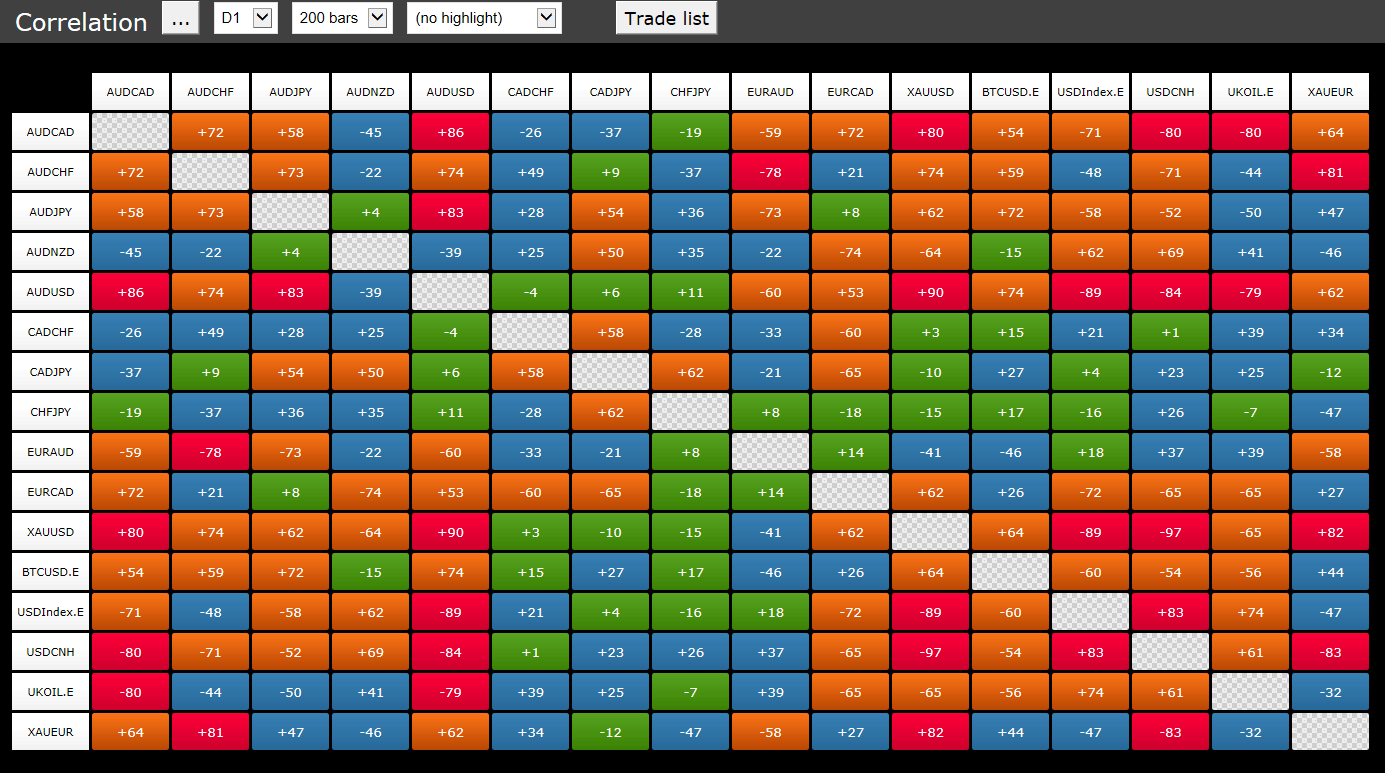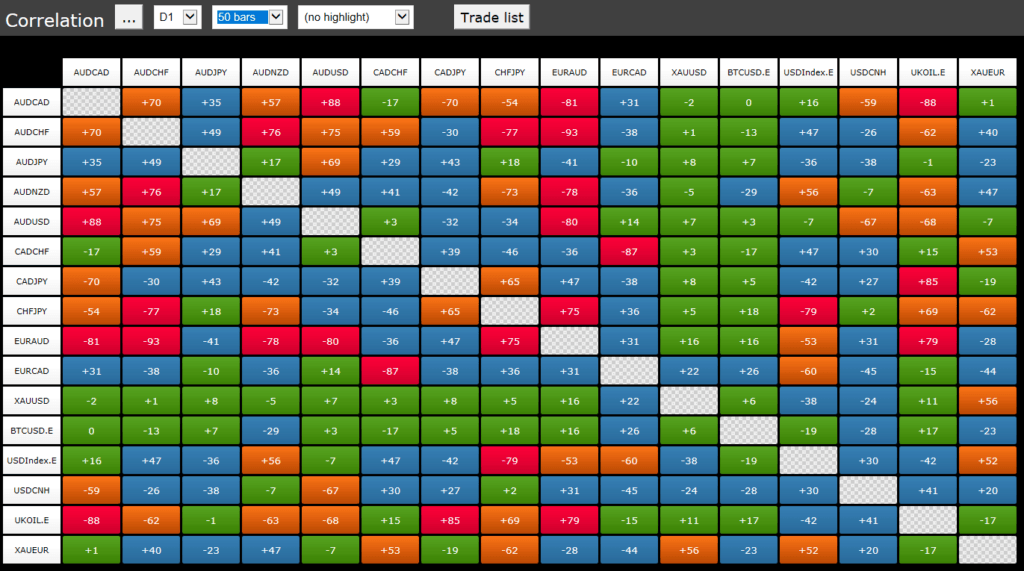Correlation, in a purely statistical sense, examines how close two variables are in having a linear statistical relationship with each other. Correlation is usually measured as a percentage, ranging from -100% to +100%, while other notations specify it to stand from -1 to +1, which is essentially the same thing. Overall, a relationship close to -100% suggests that the two variables have a close negative linear relationship, i.e. that as one decreases, the other is expected to increase. If correlation is close to +100% then the two variables are said to have a positive relationship, i.e. if one increases, the other is also expected to increase. If correlation is close to 0, then the two variables are said to exhibit no evidence of a linear relationship. The percentage associated to the relationship essentially specifies the number of times that a co-movement occurred. For example, a 70% correlation suggests that in 7 out of 10 times, if variable X increases then variable Y will also increase. Naturally, the possibility of having a 100% correlation between two variables is very small, given that other factors are also likely to have an impact on the relationship.
Note that evidence of a linear relationship between two variables does not suggest the direction of this relationship. To put it differently, if variable X and variable Y have a correlation of 90%, there is no indication whatsoever that either X causes Y or Y causes X. It only says that the two variables move in unison, and not whether variable X affects variable Y or vice versa. Still, the direction of causation does not really matter in many applications and neither it does when it comes to FX trading.
The table above, obtained through HotForex Premium Tools – Correlation Matrix, shows the correlation between various types of pairs. The main diagonal is left empty given that the correlation of a variable with itself is, by definition, 100%. Note that in this example, I have used 200 observations (i.e. close to one year), at a daily frequency. Naturally, traders wishing to observe shorter-term relationships can arrange this for e.g. 1-minute charts. As regards the choice of sample, there are two consideration traders should bear in mind: larger samples usually lead to more concrete (i.e. correct) estimates, however, they may not be very good in showing short-term changes in the relationship. Hence, the proper selection of data range and the trading frequency is left to the trader to decide.
The table presents correlations on the basis of the strength in the relationship. For example, no relationship can be viewed in green colour, weak relationship with a blue colour, medium relationship having an orange colour, while strong relationship is depicted in red. For example, the AUDCAD pair appears to have a strong correlation with the AUDUSD pair, standing at 86%, while it has a negative relationship with USDCNH at -80%.
The relationships between these three pairs appears interesting but one point needs to be borne in mind: given that in FX markets pair reflect the value of one currency versus another, the relationship between AUDCAD and AUDUSD should not come as a surprise given that AUD is common in both. As such, these types of relationships do not provide more information to the trader than he previously had. If AUD rises because of a positive development in Australia, then it is more than expected that both AUDCAD and AUDUSD would also rise.
On the other hand, the negative relationship between AUDCAD and USDCNH provides more food for thought. For example, it could be the case that the AUD and the CNH are correlated positively, also given that Australia is employed as a proxy for Asia’s performance. Hence, an increase in the AUD would also make the CNH rise, which would mean that the USDCNH would drop. Another interesting relationship which can be found in the table is that the price of Gold, either in Euros or in Dollars, is positively related to the AUDCHF pair. This occurs mostly because Australia is a main exporter of Gold thus an increase in the price of Gold would boost the country’s potential. Bitcoin, on the other hand, appears to have a positive relationship with AUDJPY and a negative relationship with the USDIndex, with the latter suggesting that perhaps Bitcoin can be viewed as a safe haven against the Dollar. This is also supported by the 44% positive relationship between BTCUSD and XAUEUR, which albeit weak, also points to that direction.

In order to examine whether these relationships hold in the shorter term, we have reduced the number of observations to the most recent 50 data points. As the correlation matrix suggests, many relationships have changed, with some even changing signs. However, the strength between some still remains. For example, the link between UKOIL and AUDCAD appears to be even stronger, at -88% compared to -80% in the 200-observation window, while the AUDCAD and USDCNH relationship has weakened to -59%. Remember that a substantial amount of observations is required to draw more concrete conclusions, thus the results in this case should be viewed with even more caution.
Overall, understanding the relationship between two currency pairs can assist in creating more successful trading strategies. However, given that there will never be a 100% relationship, care still needs to be taken and proper stop loss levels should be placed.

Recommended Content
Editors’ Picks

AUD/USD weighed down by China, tariffs
AUD/USD remained on the back foot, slipping back to the area of multi-year lows around 0.5950 on the back of mounting fears surrounding tariffs and their impact on the Chinese economy.

EUR/USD refocuses on 1.1000 amid tariffs jitters
EUR/USD reversed two daily pullbacks in a row an d managed to advance to the boundaries of the 1.1000 barrier on the back of fresh weakness hurting the US Dollar and persistent tariff fears.

Gold erases gains, back to the $2,980 zone
Gold prices now lose extra ground and slip back to the area of daily troughs near $2,980 mark per troy ounce following an unsuccesful attempt to maintain the trade above the critical $3,000 level earlier in the day.

XRP drops 3% as Ripple announces $1.25 billion acquisition of prime brokerage firm Hidden Road
Ripple announced on Tuesday that it is acquiring prime brokerage firm Hidden Road to enhance its institutional offerings and increase the adoption of the RLUSD stablecoin and the XRP Ledger (XRPL).

The Fed is looking at a hefty price level
We are still in thrall to tariffs, the faux-macro “data” driving markets. The WSJ editorial board advised other countries to take their tariffs to zero so that Trump’s “reciprocal” tariffs will have to be zero, too. Cute, but no cigar.

The Best brokers to trade EUR/USD
SPONSORED Discover the top brokers for trading EUR/USD in 2025. Our list features brokers with competitive spreads, fast execution, and powerful platforms. Whether you're a beginner or an expert, find the right partner to navigate the dynamic Forex market.